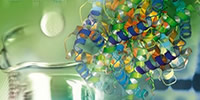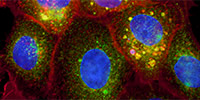INSTRUMENTS
Automated Nucleic Acid Purification System Steadi™ 12/24
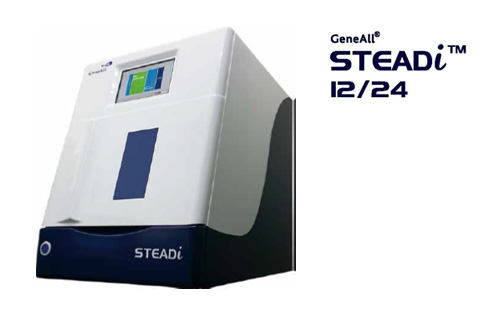
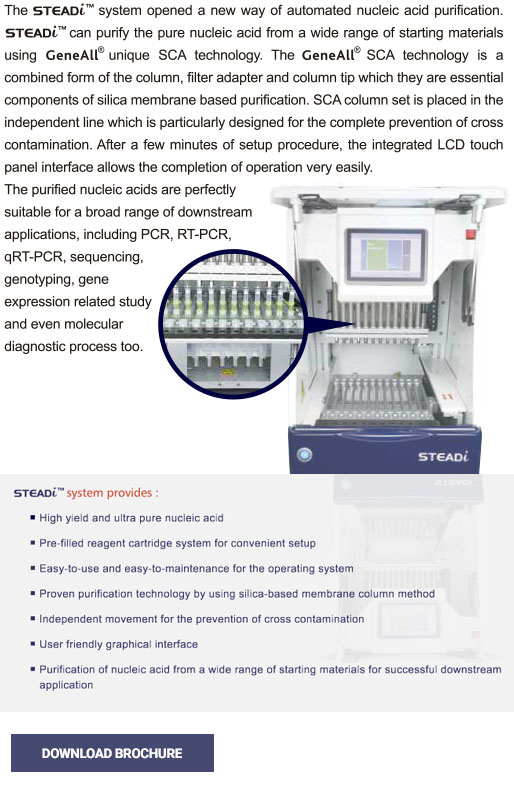
Episonic 2000 Sonication System
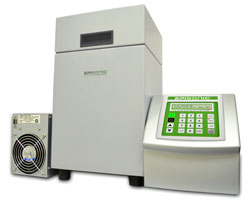
The EpiSonic™ 2000 Sonication System is the latest sonication-based instrument with integrated cooling for DNA shearing and chromatin shearing applications. This sonicator is designed for simultaneous, optimized processing of 1 to 12 samples at small microliter-level volumes (optimal at 15 µl of volume), making it an ideal solution for next-generation sequencing due to its high shearing consistency and uniformity.
Features At-A-Glance
The EpiSonic™ 2000 incorporates Digitally Adaptive Sonocavitation™ (DAS) technology to efficiently process DNA and chromatin samples, with the following key features:
- Simple input and controls
- Simultaneous sonication of up to 12 samples
- 10 minutes to shear 12 samples to 300 bp (50 sec/sample)
- Reproducible and consistent fragments
- Closed vessel processing
- Easy installation and maintenance
- Continuous cooling system
- 20-month warranty
Key Points
Notable points of the EpiSonic™ 2000 include the following:
- Generates fragments compatible with Illumina, Ion Torrent, 454, and Pacific Biosciences platforms.
- Generates tight and highly reproducible fragment distributions.
- Capable of achieving uniform fragment sizes between 150 bps and 20 kbs.
- Meets "the scientist's requirements" for a low-cost, flexible, higher throughput and easy-to-use design.
- Eliminates operator-induced variations, improves recovery yield, increases efficiency, and provides results that can be standardized.
Specifications
| Model Number | 2000 |
| Input Voltage | 100-120 VAC or 220-240 VAC @ 50/60 Hz |
| Power Rating | 750 Watts |
| Programmable Timer | Up to 10 hours |
| Operating Frequency | 20 kHz |
| Timer Control | Digital |
| Throughput Capability | Up to 12 |
| Chiller Dimensions | 7.5"L x 5"W x 7"H (19 cm x 12.7 cm x 17.6 cm) |
| Generator Dimensions | 15.25"L x 8"W x 8.5"H (38.7 cm x 20.3 cm x 21.6 cm) |
| Sound Enclosure Dimensions | 10"L x 10"W x 16.5"H (25.5 cm x 25.5 cm x 42 cm |
| Operating Environment |
Temperature: 39°-95°F (4°-35°C) Relative Humidity 20-90% (Non Condensing) For indoor use only |
| Origin of Manufacture | USA |
| Warranty Period | 20 months |
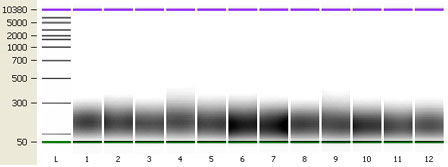
Fig. 2. Demonstration of consistent fragments achieved with a single run of 12-sample multiplex shearing with the EpiSonic™ 2000.
DAS™ technology, incorporated into the EpiSonic™ 2000, provides the following advantages:
| Controlled energy delivery | User selectable fragment lengths |
| Isothermal environment | High sample recovery with no heat damage |
| Non-contact, closed vessel processing | No cross-contamination, no aerosols, no clean up |
| Enhanced reproducibility | Micro-scale sample volumes |
| Uniform multiplex sample shearing | Real-time process monitoring |

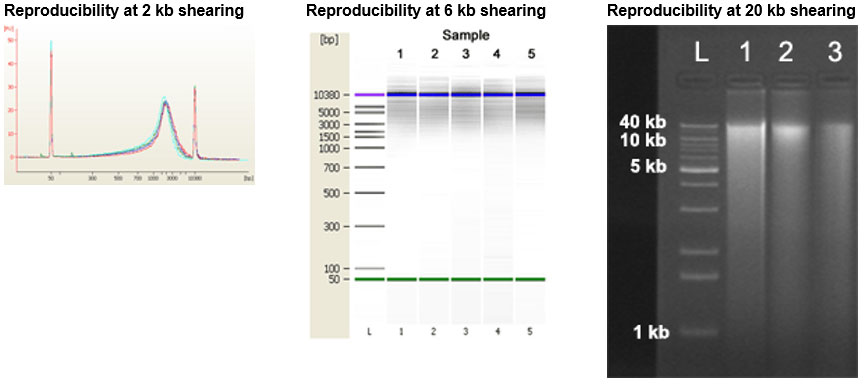
Elispot Analyzers: EliScan & EliScan Plus
Eli. Scan is a cost-efficient solution for labs which have only a limited number of plates to measure and no demand for a high throughput system.
It has been designed for the exclusive measurement of punched-out well bottoms from Millipore MultiScreen® plates detached Nunc SilentScreen® membranes and is characterized by a very compact design and a high scanning speed.
The instrument comes as a complete system including scanner unit, PC with Windows 7 Professional®, ELISPOT Analysis Software V5.1, TFT screen, color ink printer and two years warranty. Optionally Eli.Scan can be ordered with a notebook instead of the office PC.
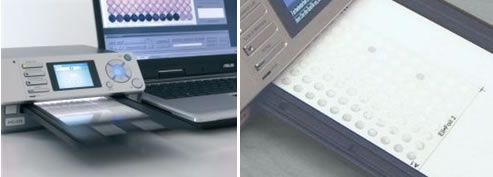
Universal Plate Scanner Eli.Scan Plus offers the complete functionality of the Eli.Scan ELISPOT Scanner
It is able to measure ELISPOT Assays based on detached Nunc® membranes or punched-out well bottoms from Millipore® plates.
In addition it supports the analysis of 6/12/24/48 and 96 well microtiter plates with transparent well bottoms.
The instrument comes as a complete system including scanner unit, PC with Windows 7 Professional®, Eli.Analysis Software V6.0, TFT screen, color ink printer and two years warranty. Optionally it can be ordered with a notebook instead of the office PC.
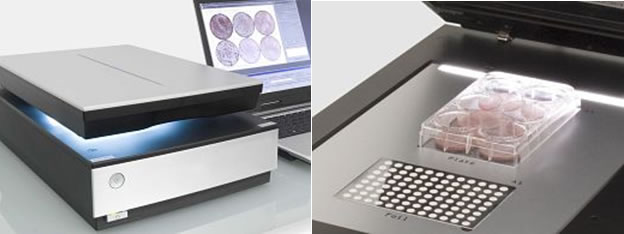
Eli.Punch ist a tool to easily transfer the well membranes of 96 well Millipore plates to the adhesive foil Eli.Foil. These foils can be read in by our Eli.Scan or Eli.Scan+ instruments. In addition it’s a suitable solution for a space saving storage of your ELISPOT assays
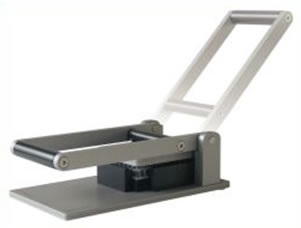
Eli.Foil is a specially designed adhesive foil for punching out the membrane bottoms of 96 well Millipore plates. The foil contains glue only at the locations where the well bottoms will be sticked. This means no more sticking between the bottoms, on the scanner, at your fingers or in your lab journal
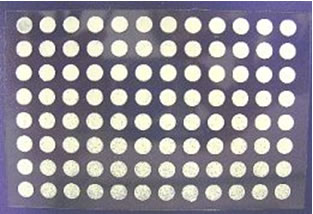
Multiplex Biomarker CCD Analyzer: Cirascan™ Imager
Cirascan™ is a specially designed imager that captures multiple images from a Ciraplex array, using an astronomy-grade cooled CCD camera with high-end optics. The imager uses a patent pending multiple exposure image acquisition algorithm to produce a high resolution composite image of each chemiluminescent array plate. An easy to use interface allows new users to operate Cirascan with minimal training. Simply prep samples using familiar ELISA protocols, place the plate into the compact, benchtop imager, and receive fully analyzed results within minutes!
Cirascan’s intuitive Apple iPad touch screen user interface allows researchers to select a plate layout created at their desktop computer and enter it on Cirascan via a network connection, Sample identification information can be entered directly into a plate layout with the optional Cira™ barcode reader
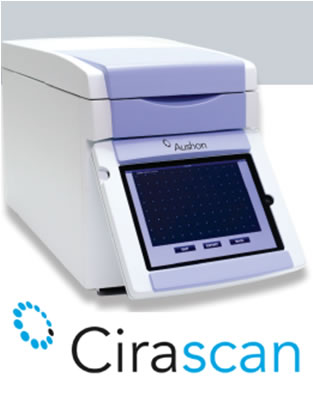
Cirascan™ is designed to capture a series of images, offering an improved broader dynamic range of assay quantification. Rapid imaging (typically <2 minutes per plate) and a fixed-focus setting – so no focus adjustments are required from one image to the next – make it easily shared by multiple users. Plus, automated calculations of image time make the instrument incredibly easy to use.
- Complete System: Imager (integrated with embedded Mac mini computer and iPad™ user interface), and array analysis software
- Performance: Improved sensitivity and dynamic range
- Fast: Typically generates 16-bit images in <2 minutes
- User-friendly: Integrated touch screen user interface for image capture and storage; Fixed-focus setting and automatic calculation of optimal image times
- Accuracy: Customized array software locates each spot in the image, measures density values and calculates pg/ml values for unknown samples from standard curves. Spot location and analysis is automatic and rapid. Providing nearly immediate access to measured sample concentrations.
- Quality: Custom, high resolution camera/lens for improved image quality and more consistent results
- roductivity: Image acquisition can take place at the bench, analysis at desk – freeing the imager for other users or to run more plates.
- Secure: Images can be archived for a permanent record of raw experimental data
- Set-up: Simple, fast, out-of-the-box installation – ready to use with minimal instruction
- Compact: Uses <2 sq.ft. of bench space; All components integrated with embedded MacMini and iPad user interface, eliminating need for separate system components
- Maintenance-free: Unlike fluidic array analysis systems, no daily, weekly or monthly maintenance is required
Imager Specifications
- Dimensions: 11” wide x 14 ¾” high x 24” deep
- Type of CCD: Front-illuminated
- Single Exposure Data Acquisition: 16 bit
- Resolution: 2184 x 1472 pixels
- Pixel Size: 6.8 x 6.8 µm
- Single Exposure Dynamic Range: 65,000 grayscale
- Cooling: -23â°C
- Electrical Configuration: 100-240 VAC/1.8 amperes/50-60 Hz >
Comet Assay Equipments
CometAssay® Electrophoresis System

FEATURES:
- Maintains constant buffer temperature with cooling pack chamber and one-piece molded plastic body.
- Maintains optimal buffer level for consistent results with overlay.
- Specially designed trays accommodate 2, 20 and 96 well slides and maintain correct position during electrophoresis.
- Optimized for use with CometAssay Kits and CometAssay Control Cells.
- Available with area specific power supply.
Trevigen's CometAssay® ES Il enables investigators to consistently optimize alkaline and neutral comet assays for highly reproducible results, and to standardize electrophoresis methods between individual users and laboratories. Comet assay results can be variable depending on temperature, distance between electrodes, and buffer height. Trevigen has solved these problems by developing a specialized electrophoresis unit.
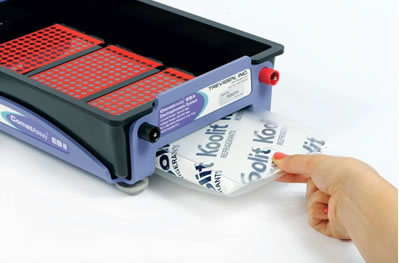
CometChip®
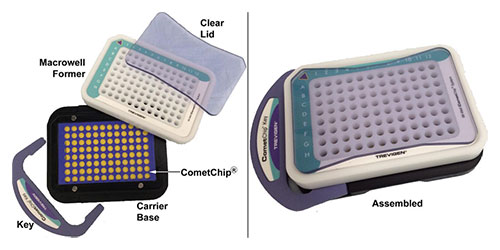
Trevigen’s 96-Well CometChip® System (Figure 1) is a high through-put 96 well platform to treat, electrophorese and measure DNA damage, in one or more cell types, on a single slide using the comet assay. The CometChip® is an array of spatially encoded micropores patterned on agarose. 96 separate macrowells, each containing ~400 micropores, are created by inserting the CometChip® into a magnetically sealable cassette. Cells added to each macrowell are deposited by gravity into the micropores - creating a pattern of non-overlapping cells (Figure 3A, Section IX Data Interpretation).
Multiple experimental conditions are performed and evaluated in parallel by the addition of different chemicals to respective wells. Once treatment is complete and the CometChip® removed from the magnetic cassette, an LMAgarose overlay is added to immobilize the cells within the micropores. When performing the Alkaline CometAssay®, the CometChip® is immersed in Lysis Buffer for gentle cellular lysis, followed by Alkaline Solution to unwind and denature the DNA and hydrolyze sites of damage. Comets are developed by alkaline electrophoresis using Trevigen’s CometAssay® Electrophoresis System. Subsequent staining with SYBR® Gold, a fluorescent DNA intercalating dye, allows visualization of the comet tail shape for assessment of DNA damage by fluorescence microscopy.
Laboratory equipments
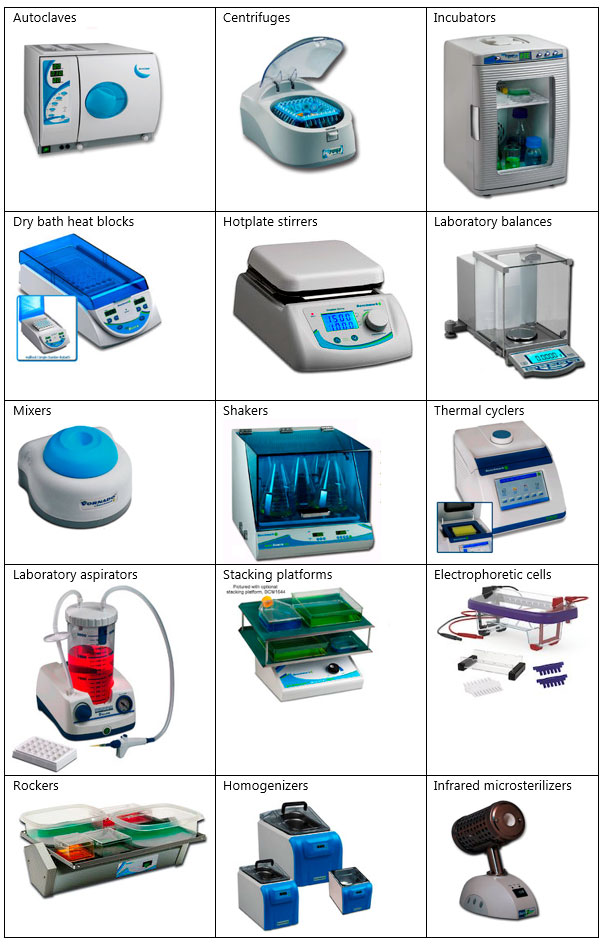
VersaWave Spectrophotomer
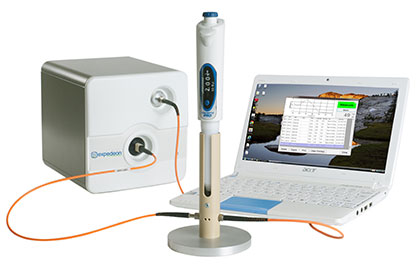
The VersaWave is an innovative microvolume spectrophotometer which is an improvement over traditional spectrophotometers and other microvolume spectrophotometers. The VersaWave provides the unique ability to analyse samples directly in a pipette tip to allow fast measurement and full sample recovery. This method of sample measurement overcomes many of the issues encountered with other microvolume spectrophotometers, such as the risk of cross contamination, sample evaporation, surface tension effects, and non-fixed pathlength. The VersaWave can also read standard cuvettes and is easily compatible with a number of attachments due to its external optical fibres.
- Full sample recovery and non-destructive measurement
- High accuracy with low variability
- Versatility thanks to different accessories
- Fast and straightforward measurements
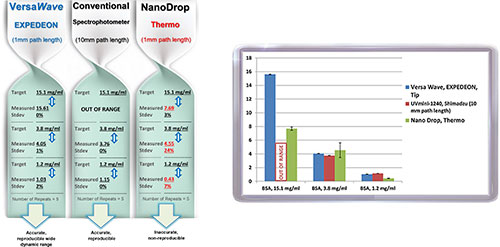
Features & Benefits
- Measure directly in tips – Fast measurements with full sample recovery
- Disposable UV transparent tips – No cleaning or risk of cross contamination
- Protected samples – No evaporation or surface tension effects
- Fixed 1mm pathlength – Wide dynamic range and no dilution
- External optical fibres – Easy coupling to versatile range of accessories for extended dynamic range
- No moving parts – No calibration or servicing required
- Compact hardware – A small footprint saves valuable bench space
- Dedicated software – Intuitive touch screen interface for minimised training time and streamlined usage
- Laptop Included – Portable touch screen laptop comes with software preinstalled
- UK manufactured – Expert local technical support
Additional Information
| Wavelenght range | 190 nm – 1050 nm |
| Spectral Bandwidth | < 2 nm |
| Photometric linearity | Better than 1% linearity |
| Photometric range | -0.2A to 2.5A |
| Absorption precision | 0.003A |
| Pathlength | 0.125 mm to 40 mm (dependant on attachments) |
| Light Source | Pulsed Xenon lamp |
| Lamp Life | Up to 10 years in normal operation |
| Detector | UV enhanced 3648 pixel CCD Array |
| Dimensions | 18 x 18 x 17 cm |
| Weight | 2.5 kg |
| Power Supply | 24V DC from supplied adapter (100 – 240V) |
| Warranty | 1 year, extendable to 2 |
